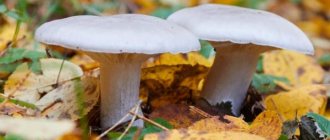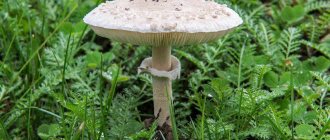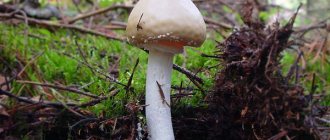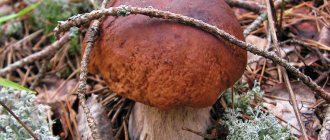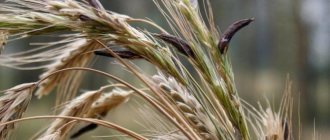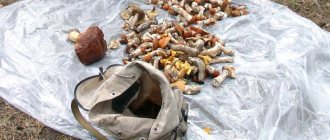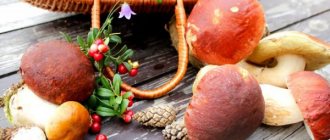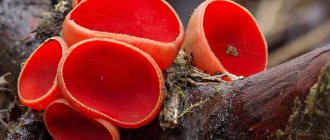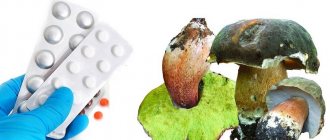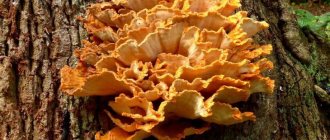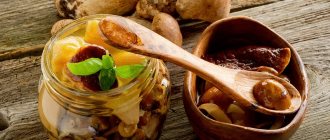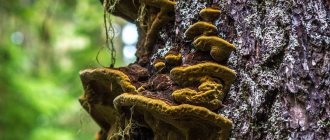The Krasnodar Territory and Adygea are one of the most unique regions of Russia in terms of their landscape, diversity of soil types and climatic conditions. Even children know how fertile this region is; it is not for nothing that there is a saying that here you can stick the handle of a shovel into the ground and after some time it will sprout. The diversity of nature is facilitated by the unique geographical location of the region, which presents climatic types from subtropical to forest-steppe. The foothills of the Caucasus Range, located on the territory of the region, also add variety. All these factors determine the enormous diversity of biological species, and the kingdom of mushrooms is no exception.
The Krasnodar region is a kind of Mecca for mushroom pickers. This is understandable, the mushroom season here begins in early spring and ends in late autumn, and the region can rival Primorye and the Far East in the diversity of commercial mushroom species. In fact, in a relatively small geographical area there are concentrated species of fungi that are characteristic of all natural zones of Russia, with the exception, perhaps, of endemic species that are unique to one particular area.
It will be most convenient to arrange edible mushrooms of the Krasnodar region according to seasonality of collection, since due to the lack of clear boundaries of climatic zones, species are not tied to any one region of the region.
Spring mushrooms
Oyster mushroom
Spring oyster mushroom
Among local residents, the name “birch bark” is more common. A fungus that parasitizes the wood of deciduous trees. It has peculiar “ear”-shaped caps and a very short or missing stem.
Grows in large clumps. In the Krasnodar Territory, it begins to bear fruit from the beginning of May until winter, and guests from other regions of the country are often amazed at the size of the oyster mushroom “families” and its fertility.
Golovach is round
Baggy golovach
One of the earliest mushrooms in the region, it begins to bear fruit in mid-April. Quite a large mushroom, strongly reminiscent of an ordinary raincoat. It differs in that it has a false stalk, which is part of the general fruiting body.
Almost simultaneously with it, the giant bighead, distinguished by its larger size, and the spiny raincoat, a typical spherical raincoat, decorated with small soft spines, appear. All three species are edible only when young.
Gray dung beetle
A low, gray mushroom with an ovoid and later bell-shaped cap, covered with small scales. Unlike other regions, where this type of mushroom mainly accompanies human habitation and agricultural buildings, in the Kuban this mushroom can be found almost everywhere, with the exception of areas with clay soils. This is explained by the rich composition of the soil layer. It begins to bear fruit very early, from the beginning of April.
Gray dung beetle
Common champignon
Common champignon
A fleshy lamellar mushroom with aromatic flesh, a grayish scaly cap, a dense ringed stalk and a pink or brown lamellar layer. In the Krasnodar Territory, its fruiting begins in mid-April, much earlier than other regions. It grows here surprisingly abundantly, sometimes covering entire clearings with its fruiting bodies.
I personally, in the vicinity of Apsheronsk, collected three buckets of champignons in 15 minutes at one small forest edge. And this despite the fact that I chose only specimens no larger than 5 centimeters.
Somewhat later, around the beginning of May, another type of champignon appears, field champignons. It is easily distinguished by its anise-scented pulp and white cap with small yellowish spots. In Kuban they grow as abundantly as the common champignon, preferring open space. Very often they can be found on agricultural lands, especially those that are fallow.
Podvishen
Podvishen
A mushroom that resembles a large white or grayish chanterelle with a mealy odor. In the Khadyzhensk region, individual specimens of these mushrooms have been found since mid-April; by the end of the month, cherry blossoms are already bearing fruit abundantly throughout the region.
Porcini
Porcini
A powerful tubular mushroom with a cylindrical or club-shaped stalk, a convex or pillow-shaped cap and skin color ranging from almost white to brown, depending on the place of growth and climatic conditions. Yes, don’t be surprised - in Kuban it is classified as a spring mushroom. Or, rather, to all-season, since the first specimens appear already in May, and the last finds of porcini mushroom occur even at the end of November. The porcini mushroom is found especially abundantly in the foothills, in open forests.
Moss fly green
A typical representative of moss mushrooms with a velvety cap and yellow flesh that quickly turns blue when damaged. In general, almost all types of moss mushrooms are represented in the Krasnodar Territory, but the green variety appears here first, in mid-April or early May. Its brother, fissured moss, begins to grow a little later, from mid-May.
Green moss
Expert opinion
Gennady Sergeevich Rylov
A great expert in mycology and an avid mushroom picker. Knows everything about mushrooms, their types and places of growth
This is not a complete list of spring mushrooms in the Krasnodar region - rather, I listed those mushrooms that appear in this region earlier than in other regions of Russia. Other spring species, such as winter mushrooms, morels, stitches, and winter honey mushrooms, are no different in seasonality here from other regions.
Summer mushrooms of the Krasnodar region
Summer is a period of real forest riot of mushrooms in Kuban. It would be quite difficult to list all the species that can decorate a mushroom picker’s basket in the middle of the summer season, because it would result in a whole scientific work. Therefore, I will limit myself to the most common and massively growing species that form the basis of commercial mushroom collection.
Common boletus
Common boletus
It begins to bear fruit here at the end of May, and its season ends in late autumn. A typical boletus mushroom, tubular, the cap is hemispherical or cushion-shaped, the stem is scaly, smooth or widening at the base, with flesh bluish along the edge. A pleasant feature of these mushrooms in the Krasnodar region is that watery specimens characteristic of the middle zone are almost never found here. In Kuban, almost all boletus mushrooms are dense and elastic. True, the worms also eat them very actively and it can be difficult to find an intact specimen.
Boletus
Boletus
Around the same time, aspen boletuses, red and yellow-brown varieties, appear in forests and pendants. These are dense tubular mushrooms with a stem covered in black scales, a dense convex cap of yellow, brownish, red or brick colors. Easily distinguished by the intensely blue flesh when broken.
In the Kuban, these mushrooms grow especially abundantly on the border of the forest-steppe and subtropical zones, in particular in Krasnaya Polyana. Large populations were also seen in the Belorechensk area. In the Krasnodar Territory you can find truly gigantic specimens of boletus mushrooms; the personal record of the author of this article is a mushroom that fell slightly short of 3.5 kilograms. And without a single worm, as is typical for boletus.
Camelina Pine, here more often called “delicious camelina”
A small lamellar mushroom of red, reddish, sometimes with a greenish tint, with a convex or funnel-shaped cap. In the Krasnodar Territory, this delicious mushroom has taken a liking to the foothills and slopes of low mountains, where it is found very abundantly. Very large harvests are collected by local residents in the area of the village with the unpronounceable name Arkhz, and large populations also grow near the village of Chibiy.
Pine mushroom
Real milk mushroom
Real milk mushroom
A large, massive mushroom with a flat depressed or funnel-shaped cap, white or yellowish in color, abundantly releasing caustic milky juice when broken. The real “mushroom gold” of Russia.
Unlike more eastern populations, in the Krasnodar Territory this noble mushroom is found mainly in mountainous areas, most often in the vicinity of hornbeams. In the flat parts of the region it can only be found where loamy soils predominate.
White truffle
White truffle
This mushroom is worth mentioning separately, since in our country the Krasnodar Territory is perhaps the only region whose climate is favorable for the growth of this rare and capricious mushroom. In any case, it is regularly found only in Kuban. Externally, the mushroom resembles a rather untidy gray or brown potato of irregular shape.
The fruiting body is completely immersed in the soil, so picking these mushrooms is a separate form of art. In the Krasnodar Territory, it is most often seen in mountainous areas or foothills, in particular, in the vicinity of Apsheronsk. Grows strictly on calcareous soils.
Autumn honey fungus
Autumn honey fungus
Saprotrophic mushroom, grows on weakened or dead wood, small, with a convex or outstretched cap, covered with scales and a characteristic ring on the stalk. It grows in groups; in the Kuban there are often standing trees covered with honey mushrooms from the soil to a height of 3 meters. Here it is more often called “true honey fungus”, since in the Krasnodar region the active growth of this fungus begins much earlier than, for example, in central Russia.
Mushroom pickers begin to collect it from the beginning of June, then the honey fungus produces several “layers” and continues to bear fruit until the end of November. So it can be safely classified as both summer and autumn mushrooms of the region. Here, honey mushrooms are chosen by the mountainous regions of the forest-steppe and subtropical zones, but they are also found on the plains, although not so abundantly.
When and where to go on a “silent hunt”
Mushrooms of Crimea in 2022: the best places and collection season
As in most regions of Russia, Kuban mushroom pickers begin collecting in late summer - early autumn. However, the exact answer to the question of when to pick mushrooms depends on the specific variety. Some are found only in the first half of autumn, when the weather is warmer, others, on the contrary, grow until the first frost. There are also those that grow already in May.
Experienced mushroom pickers know that the best harvest can be harvested in the Absheron and Tuapse regions. Chanterelles, oyster mushrooms, and russula are found here. The more common boletus and honey mushrooms grow in almost all populated areas. Most often, porcini mushrooms are collected on the territory of Saratov, Smolensk, Kaluga villages, and honey mushrooms - in Goryachy Klyuch and in the vicinity of Krasnaya Polyana.
If you love milk mushrooms, then you should go to Dakhovskaya, Smolenskaya or Kaluga Stanitsa. Boletus and boletus grow in forest areas in the vicinity of mountains and in the coastal area.
Autumn mushrooms of the Krasnodar region
In fact, there are few species growing exclusively in the autumn season in Kuban. This is due to the fact that the climate during the mushroom season is quite even, and therefore many species that are considered purely autumn in other regions grow safely here in the summer, and often in the spring.
Violin
A mushroom that looks like a milk mushroom with a flat, depressed or funnel-shaped cap, white or with brown spots. We can easily distinguish it by the characteristic squeaking sound that the cap’s flesh makes when you run it over a nail or tooth. In Kuban it grows for only 2 months, September and October.
In different years it may occur in large quantities or not at all. The largest populations are observed in the area of Goryachiy Klyuch and the village of Kaluzhskaya, growing in oak and hornbeam forests.
Violin
Poplar row
Poplar row
A lamellar mushroom with a convex, later outstretched cap of a brown, reddish color, sometimes with green spots; in old mushrooms the caps are wavy, irregular in shape, with cracks. A distinctive feature is the mealy taste of the pulp, which is distinctly crunchy on the teeth. One of the latest mushrooms of Kuban, at the same time one of the most widespread and abundant.
During the season it is found throughout the region, and is so numerous that it is almost the main pickling mushroom. At the same time, two more types of rows are growing, the earthen row (here it is called “earthy”) and the yellow-red row.
Herbaceous scale
Grass scalehttps://gribowiki.ru/inedible/feolepiota-zolotistaya.html
The local name is golden flake (not to be confused with golden flake, which is a completely different species). Large, up to 25 cm in diameter of the cap, a lamellar mushroom of yellow, reddish or orange color, the stem has a ring.
This mushroom grows exclusively in October on black soil and is quite rare. In modern literature it is classified as inedible due to the ability to accumulate hydrocyanic acid salts, but local residents continue to use it after preliminary boiling, and not a single case of poisoning has been recorded.
Poisonous mushrooms of the Krasnodar region
As in any other region, picking mushrooms in Kuban requires special care. Mushroom poisoning can be very insidious and does not manifest itself immediately, so here, as elsewhere, the iron rule of any mushroom picker applies - if you are not sure about a mushroom, do not touch it! The species diversity of poisonous mushrooms in the Krasnodar region is quite large, as in the case of commercial mushrooms; the favorable climate allows almost all toxic species of mushrooms known in Russia to grow here. So here we recall the most dangerous species that can be found in this region.
Toadstool pale
Death cap
The most dangerous poisonous mushroom in Russia. It has a hemispherical or prostrate cap of a white, grayish color, sometimes with a green sheen, a pronounced ring on the stem, and a characteristic volva at the base. I strongly recommend that you get acquainted with other signs and differences in the mushroom encyclopedia! In Kuban it begins to bear fruit in June and continues to grow until the first frost.
Entoloma poisonous
Entoloma poisonous
Quite large, with a cap up to 16 cm, a lamellar mushroom. The cap is yellowish-white or gray, and has a strong floury odor of the pulp. In Kuban it occurs during September and October, mainly in the foothills. Very poisonous!
Fly agaric red
Fly agaric red
The most famous, perhaps, is a poisonous mushroom with a bright red cap covered with characteristic white flakes, a white ringed stalk and an ovoid depression at the base. Fortunately, it is rare in the Kuban region, mainly in mountainous areas, and grows from July to September.
Satanic mushroom
Outwardly, it strongly resembles boletus mushrooms, the surface of the cap is white, grayish, the leg is yellow-red, with a bright red mesh pattern. When broken or cut, the flesh quickly turns red, turns blue along the edges, then the flesh returns to its previous white color. The mushroom is not very poisonous, but can cause quite severe stomach upset. On the territory of the Krasnodar Territory it is found quite often and abundantly, which makes it dangerous. Grows everywhere in deciduous forests.
Satanic mushroom
Expert opinion
Gennady Sergeevich Rylov
A great expert in mycology and an avid mushroom picker. Knows everything about mushrooms, their types and places of growth
It is important to note here that this list is far from complete. Almost all types of fly agarics, a huge number of toadstools and hallucinogenic mushrooms grow in Kuban. Therefore, more complete information should be emphasized from the mushroom encyclopedia, this is very important!
Map of mushroom places
The map of the Krasnodar Territory and Adygea is rich in mushroom areas, which annually attract many amateur and professional hunters.
Let's look at the table where you can go on warm spring and winter days.
| Oyster mushrooms, boletus | Moss mushrooms, honey mushrooms, chanterelles | Hornbeam, lacquer | White, boletus | Morel, truffle | Champignon, entoloma |
| Stanitsa Smolenskaya, Krepostnaya, village. Hot key | S. Arkhyz in Kuban | Stanitsa Saratovskaya, Kaluzhskaya, Kutaisskaya | Stanitsa Smolenskaya, Engelmanovaya Polyana, Absheronsky district | PGT Psebay, Smolenskaya village | Kamyshanovaya Polyana, village. Ilskaya |
To make your searches more successful and safe, experts recommend going to harvest with experienced collectors.
Little tricks of the Kuban mushroom picker
Do you explore the forests of your regions in search of mushrooms?
Of course! I'm going to
The geographical features and climate of Kuban leave their mark on such a seemingly common task as picking mushrooms.
I will list a few tips based on local specifics:
- When going mushroom hunting, choose shoes that will be comfortable for walking not only on the forest floor, but also on rocks. Many types of mushrooms will lure you quite high into the mountains, and moving there in the usual rubber boots with smooth soles will be extremely uncomfortable.
- For the same reason, it is best to use buckets rather than baskets as containers for mushrooms. It is very easy for a person unaccustomed to moving in the mountains to fall here. We can say that you will certainly fall on your first trip. An ordinary basket will most likely not withstand such a test.
- Kuban has a fairly humid climate with high summer temperatures. Therefore, containers for mushrooms must be well ventilated. It is best to make a sufficient number of holes in plastic buckets with a drill for free access of air.
For “mushroom tourism” the Belorechensky, Apsheronsky districts and the surroundings of Goryachiy Klyuch are best suited. These are the richest mushroom crops and fairly easily traversed areas.
Reviews + harvest photos
Having read many reviews of mushroom pickers who go on quiet hunts all year round, we can conclude that the territory of the Republic of Adygea is ready to treat every guest with its edible gifts. Mushrooms that grow in deciduous, mixed and coniferous forests can be used not only for pickling and pickling for the winter, but also for drying, freezing and even preparing everyday and holiday dishes.
Often, collecting several buckets of a good harvest is not difficult! Mushrooms of Adygea 2022 forum is an endless storehouse of mushroom mycelium, allowing you to fill the baskets of both local residents and visitors who decide to hunt in these parts.
